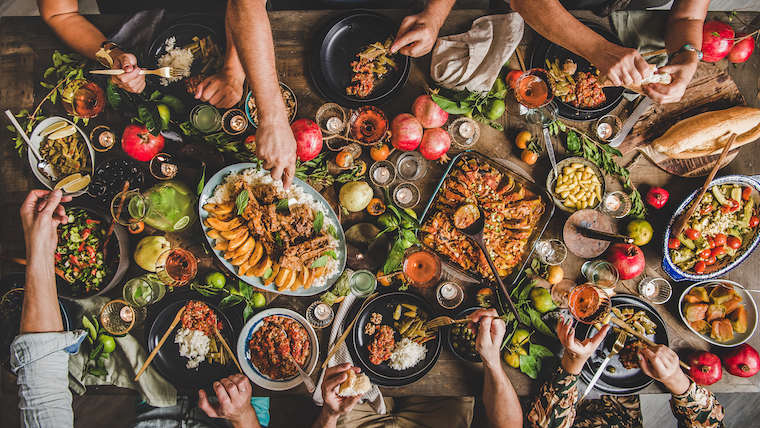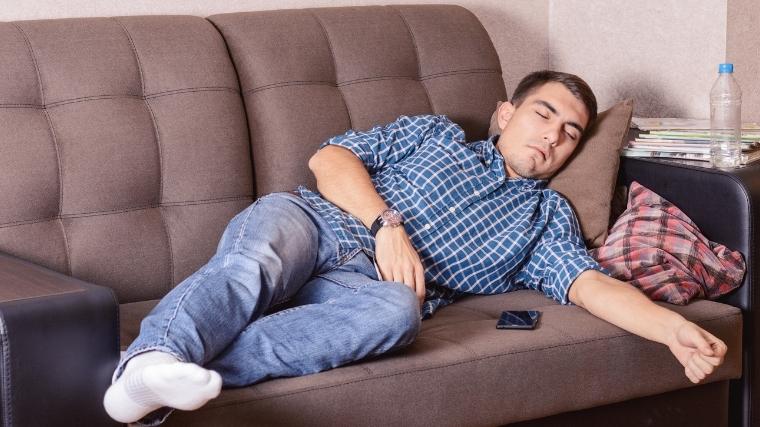We are going ham on Thanksgiving…err…turkey! Thanksgiving dinner is often a gluttonous feast of poultry, pie, cider, and yams — plates of dates and gravy, mashed potatoes, casseroles, and cranberries. Marshmallows on sweets, too much booze in the drinks, and a food coma fit for the festivities. But what is a food coma? That is, the sleepiness commonly experienced following the consumption of calorie-rich meals. (1)
Why does the couch seem like the most comfortable place following a massive meal? Why does the sandman gain so much power following a feast with a caloric density fit for a silverback gorilla? Let’s dive into what’s going on with your body when a food coma inevitably strikes during the holiday season and how to navigate it in a way that avoids the dreaded post-meal, full-belly nap.

[Related: How to Gain Muscle — A Guide to Eating for Mass]
What Is a Food Coma?
A food coma is a colloquial term for postprandial somnolence, which essentially means drowsiness after a meal. You may have read that turkey contains an amino acid called tryptophan, a precursor to serotonin, which causes sleepiness. It’s a bit misleading to suggest tryptophan as the primary cause of drowsiness, though. Serotonin is associated with sleep triggering, preparation, and maintenance, but it is also present at keeping one alert during stressful events. (2)
So it depends on the circumstances for the tryptophan, and therefore serotonin, to make you drowsy. If we assume that a holiday meal is a relaxed endeavor, then the science is there to suggest that tryptophan decreases anxiety and increases positive mood. (3) That might be why eating is fun and a likelier cause of drowsiness. The real culprits behind your post-meal snooze, though, are the volume and makeup of the meal.
The volume of food you eat and its macronutrient composition are more robust indicators of whether or not the meal will impact how sleepy you are afterward and the quality of the sleep you’ll get.

A meal higher in complex carbs and lower in fat will likely lead to reduced sleep-onset latency (the time it takes to go from wakefulness to sleep) than if the meal’s fat content is higher and the complex carb content is lower. Additionally, high-carb, low-fat meals are likelier to increase slow-wave sleep (read: deep sleep) and rapid eye movement (REM), both of which are better for recovery. (4)
Leaning more towards complex carbs and away from fats may help fight a food coma. Blessed be the stuffing (assuming it’s not laced with mountains of butter). But let’s be real, we didn’t bring a delicious apple cinnamon pecan pie to the family gathering to not destroy all of it and more. Just be aware that a sugar rush (i.e., a lot of simple sugar) will likely make you feel quite sleepy within an hour after consumption. That sugar-fueled sleep is unlikely to make you feel refreshed when you wake, nor will you sleep through the night — greater sugar intake has been shown to lead to sleep that lasts less than five hours. (5)
Combat the Coma
If you don’t want to fall asleep while the holiday festivities continue post-dinner, there are a couple of lines of attack you can prepare to take. The first option may not be popular, but it is likely to be effective:
Eat Slower
For you to feel full, your brain has to know that your body is satiated. This happens when it receives signals from the gut upon its discovery of cholecystokinin, which “controls nutrient delivery to the small intestine by inhibiting food intake and gastric emptying.” (6) However, the gut won’t signal that to the brain until the nutrients from the food are accumulated and passed into the small intestine. That means you are likely to continue eating even if your body is satiated because your brain won’t receive the signal fast enough to tell you you’re not hungry anymore. (7)
By slowing down your consumption rate, as difficult as that may be, given the desire to crush all the roasted brussels sprouts doused in maple syrup because it’s delicious, you can allow your body time to digest the food to the small intestine. By doing so, your brain will have the time to discover that you don’t need that extra heaping plateful of decadent mashed potatoes.
Move It, Move It
Suppose you fancy yourself a feisty feaster on Thanksgiving, rather than popping on the coach with some dessert wine, head outside for a walk or do some yoga or move in some capacity. Moderate exercise has been shown to improve energy levels and lower tension than staying sedentary and snacking. (8) Moving post-meal is all the more critical if you ate a decent chunk of sugar.
[Related: Nutrition for Bulking — 10 Tips for Intelligent Muscle Gain]
Food Coma Warrior
May we all be thankful for the joy of gathering with friends and family and gorging on a sickening amount of food. May we be even more grateful that after the triumph over the meal, you will forge forth as the lone individual alert and ready for activities while maneuvering through a living room battlefield of food coma-ed relatives and friends sprawled out amongst the furniture and floor!
References
- Lehrskov, L. L., Dorph, E., Widmer, A. M., Hepprich, M., Siegenthaler, J., Timper, K., & Donath, M. Y. (2018). The role of IL-1 in postprandial fatigue. Molecular metabolism, 12, 107–112. https://doi.org/10.1016/j.molmet.2018.04.001
- Cespuglio R. (2018). Serotonin: its place today in sleep preparation, triggering or maintenance. Sleep medicine, 49, 31–39. https://doi.org/10.1016/j.sleep.2018.05.034
- Kikuchi, A. M., Tanabe, A., & Iwahori, Y. (2021). A systematic review of the effect of L-tryptophan supplementation on mood and emotional functioning. Journal of dietary supplements, 18(3), 316–333. https://doi.org/10.1080/19390211.2020.1746725
- St-Onge, M. P., Mikic, A., & Pietrolungo, C. E. (2016). Effects of Diet on Sleep Quality. Advances in nutrition (Bethesda, Md.), 7(5), 938–949. https://doi.org/10.3945/an.116.012336
- Prather, A. A., Leung, C. W., Adler, N. E., Ritchie, L., Laraia, B., & Epel, E. S. (2016). Short and sweet: Associations between self-reported sleep duration and sugar-sweetened beverage consumption among adults in the United States. Sleep health, 2(4), 272–276. https://doi.org/10.1016/j.sleh.2016.09.007
- Dockray G. J. (2012). Cholecystokinin. Current opinion in endocrinology, diabetes, and obesity, 19(1), 8–12. https://doi.org/10.1097/MED.0b013e32834eb77d
- Gallagher, T., & You, Y. J. (2014). Falling asleep after a big meal: Neuronal regulation of satiety. Worm, 3, e27938. https://doi.org/10.4161/worm.27938
- Thayer R. E. (1987). Energy, tiredness, and tension effects of a sugar snack versus moderate exercise. Journal of personality and social psychology, 52(1), 119–125. https://doi.org/10.1037//0022-3514.52.1.119
Feature image via Shutterstock/Foxys Forest Manufacture